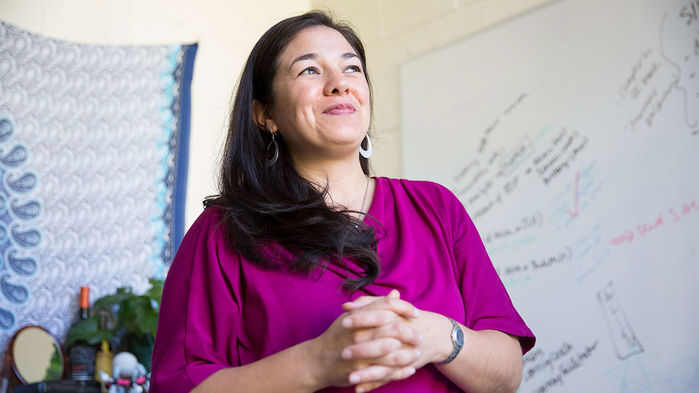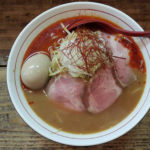By Esher Landhuis
Science, October 18, 2017 —
On a calm September evening in 2010, Alegra Eroy-Reveles had come home from lab and put her toddler to bed when a dear friend called. As they talked, Eroy-Reveles scribbled with a marker on the mirrored closet door, like she did on fume hoods in the chemistry lab where she worked as a postdoc at the University of California (UC), San Francisco. The conversation touched on proteases, probes, experiments that weren’t working, and her disillusionment with the pressure to publish. But it took a turn when the friend said she was dying of breast cancer.
The news made the chemist rethink her calling. The postdoc position was hard-fought, especially as an underrepresented minority in science, and her career path had a few redirects already. The stakes seemed high. But the phone call sparked soul-searching that brought a pivotal realization. “There’s only a limited amount of time in the day, and in my life,” Eroy-Reveles says. “I want to put my time where I can have the most impact.”

A. Alegra Eroy-Reveles, PhD
About a year later, before her friend died, Eroy-Reveles left bench science—but not science. These days, the research she conducts as an assistant professor of chemistry and biochemistry at San Francisco State University (SFSU) focuses less on advancing science and more on helping students advance—especially those from underrepresented groups. “I love synthetic chemistry. I love making molecules,” Eroy-Reveles says. “But I realized I could have a much bigger impact if I can get the next generation there, to ask really good questions. They’re not going to get there unless they get through undergraduate chemistry.”
Early exploration
Eroy-Reveles grew up in a farming community in Watsonville, on the central coast of California. Her family—a blend of Chicano, Puerto Rican, and Filipino immigrants—included teachers, nurses, and church liturgists. “They were all service-oriented,” Eroy-Reveles says. For a girl who liked math and science, medicine seemed a natural fit. “They said, ‘This is what the community needs,’” she recalls, and in 1997 she headed across the country to Amherst College in Massachusetts, thinking she’d become a pediatrician. But during her senior year, when the time came to write a personal statement explaining why she wanted to be a doctor, she couldn’t do it. “It wasn’t in my heart,” Eroy-Reveles recalls.

ACE Academic Excellence Program, University of California at Santa Cruz
Instead, she went home and taught organic chemistry and calculus in a UC Santa Cruz program aimed at supporting underrepresented minority students pursuing science, technology, engineering, and mathematics (STEM) majors—something she thought she’d enjoy while figuring out her next step.
Eroy-Reveles liked being in the classroom but also wondered about research. Despite having majored in chemistry (as well as Spanish) as an undergraduate, she had never worked in a lab. She knew some students—many of whom had Ph.D. chemists in their families—worked in research labs, but, she says, “I just thought they were all really good students and did not put myself in that category.”
Even though she was at a premier liberal arts college, which would typically offer plenty of hands-on advising, Eroy-Reveles doesn’t recall a single professor or counselor encouraging her to seek research opportunities.
Many of her Latino and Black friends, who were also the first in their families to study science, experienced a similar lack of support. “We weren’t knocking on doors, and the faculty weren’t opening them for us,” she says. “We didn’t know how important it was to do research. Honestly, we were just trying to survive and graduate.”
Once she was out of school and pondering career possibilities, Eroy-Reveles thought more about research, but she still didn’t know how to pursue that path. That changed when she attended the annual meeting of the Society for Advancement of Chicanos/Hispanics and Native Americans in Science(SACNAS). (This year’s meeting [is in] in Salt Lake City.) The conference, which she first attended the fall after finishing her bachelor’s degree, was a game-changer, and it became a cornerstone of her Ph.D. experience. “If SACNAS had not been in my life, I am pretty sure I would not be a Ph.D. scientist right now,” Eroy-Reveles says. She’s there today, helping attendees network by serving as a facilitator for pre-conference meals and mixers.
That first year, though, it was a dinner conversation with a Latina biology professor that really turned Eroy-Reveles on to research and, more importantly, demystified the path there. “She said, ‘Hey, this is what I study. This is what it’s like to have a lab. This is what it means to go to grad school,” Eroy-Reveles says. With that insider knowledge, she decided she would give it a try.
Eroy-Reveles emailed a handful of UC Santa Cruz chemistry professors, found part-time lab work purifying proteins and studying transition metals, and applied to the university’s chemistry Ph.D. program. Having earned Cs in organic chemistry as an undergraduate, Eroy-Reveles was floored to score 97% on her Ph.D. entrance exam—success she attributes to two quarters of teaching that brought greater mastery of the material. “It was incredibly empowering,” she says. “I tell my students … your grades do not define you. They’re just a snapshot.”
As a Ph.D. student, Eroy-Reveles enjoyed digging into the literature, seeing the history of scientific inquiry and discovery, and asking questions. “I loved doing research,” she says. At the same time, she knew she wanted to get back into the classroom. Like many Ph.D. students, she was aiming for a faculty job that would allow her to both conduct research and teach.
With this plan in mind, Eroy-Reveles was intrigued to learn—again at a SACNAS meeting—about the Institutional Research and Academic Career Development Awards (IRACDA). The National Institutes of Health offers these awards to postdocs who, in addition to conducting research, want to build classroom and mentoring skills through teaching internships at partner institutions. But her thesis adviser dissuaded her from applying. He told her postdocs are not supposed to teach and that “it would be a shame if I didn’t apply for ‘traditional’ fellowships because I was a minority applicant with a strong publication record,” Eroy-Reveles says. Thoughts about IRACDA fell by the wayside as she landed a postdoc at a high-powered research institution, UC San Francisco. That was her “test,” she recalls. “Could I do research for research’s sake?”
Two years into learning mass spectrometry and synthesizing protease inhibitors, Eroy-Reveles had a nagging sense the answer was no. Her true passion was working with students. If she ran a synthetic chemistry lab, she could train five, maybe 10 students at a time. Yet as a teacher, she could influence hundreds in one semester. “There was that amplification aspect,” Eroy-Reveles says.
She told her postdoc adviser, Charles Craik, that she wanted to focus more on teaching. “The more we talked, it seemed that she could use her exceptional skills, enthusiasm and experience to have an impact by teaching,” Craik wrote in an email to Science Careers. “As long as she was going to follow her passion and do her best to excel, I was supportive.” Craik connected her with a biology professor friend at SFSU, who suggested that she consider IRACDA. This time she did apply, and she got it. The training and mentorship that came with this fellowship set her on the path to her current role.
Building community
Today, instead of building molecules, Eroy-Reveles pours her energy into creating culture, with the aim of keeping young scientific minds from slipping through the cracks. “Not everyone can do the job,” says SFSU math professor Eric Hsu, who interviewed applicants for the position Eroy-Reveles now holds. More than half of SFSU’s students are minorities. Many are the first in their families to attend college. On top of classes, some work multiple jobs to support their families. (Throughout her own undergraduate training, Eroy-Reveles held a work-study job at the post office.) Despite the challenges, Hsu says, “if you really connect with students, if you really put in that work, … you can make huge changes in people’s lives. Alegra got it right away.”

A. Alegra Eroy-Reveles, PhD. (Susan Merrell)
Building a supportive learning culture takes many forms. Sometimes it means encouraging other professors to emulate what their colleagues are already doing to engage and nurture students. At a recent orientation for new faculty members, Eroy-Reveles read aloud from a syllabus in which math professor Federico Ardila promises students will be “challenged and supported” as they “build [a] rich experience together.” He asks them to “take an active, critical, patient, and generous role in your own learning and that of your classmates.” Some of the new faculty members were stunned. “They were like, ‘Oh my God, you can write that in your syllabus?’” Eroy-Reveles says. “We’re telling everyone it’s OK to come out from behind that screen to say, ‘I’m a person and I want this to be joyful and meaningful.’”
Other times, shaping healthy culture demands dealing with negativity. Last spring, Eroy-Reveles led a workshop for students and educators about “stereotype threat”: the fear of confirming a negative stereotype about one’s social group, which can in turn hinder performance. For example, students from underrepresented groups tend to underperform in math and science because they fall prey to stereotypes that they don’t belong or don’t do well in those subjects. The workshop was intimate and interactive, with attendees sharing stories of how they dealt with academic failure. When the workshop ended, one graduate student thanked Eroy-Reveles, teary-eyed because the discussion legitimized pain she’d felt for years in a male-dominated engineering lab.
Eroy-Reveles has also transformed a set of small courses for students looking for extra help with large lecture-based STEM classes—SFSU’s version of the classes she taught at UC Santa Cruz. The key? She pushed for peer-led learning by inviting undergraduate instructors into these classes, which were traditionally taught by graduate students. In conversations and course evaluations, students said learning felt less threatening when led by a fellow undergraduate. Whereas they considered graduate student facilitators “the teacher,” they saw undergraduates more like peers “who would come and sit down next to me and help me work this out,” Eroy-Reveles says.
And sometimes it’s the facilitator who needs an extra welcome, which Eroy-Reveles is quick to offer. At a new facilitator training session several years ago, she noticed one standing alone, withdrawn. The Latino student confided that he felt like he didn’t belong. Overhearing the other facilitators talk about their high GPAs and plans to apply to Ph.D. programs at elite East Coast universities—“Dude, that was so intimidating,” he says. “Alegra came over and said, ‘Hey, why aren’t you talking? It’s not a mistake that you’re here.’”
As Eroy-Reveles empowers SFSU students along the tough road toward STEM careers, they encourage her too.
“Even though I am ‘the only’ in my department—the only female underrepresented minority, the only assistant professor with children, the only one doing education research—I know I will find allies across campus and students who can identify with my experience,” she says.
And the dear friend she lost to cancer 5 years ago lives on through her teaching. In an introductory chemistry lecture earlier this month, Eroy-Reveles told her students about radioisotopes and positron emission tomography (or PET) scans, which she’d taken her friend to get several times during her treatment. “When I teach, I honor her,” she says.
Esther Landhuis is a freelance science journalist based in the San Francisco Bay area.











